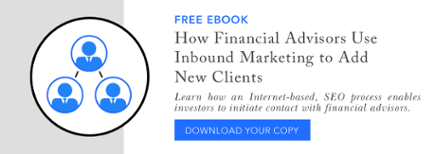What Type of Digital Marketing Services Are Most Successful
When discussing a good marketing plan with financial advisors, it’s surprising how many don’t have one at all. They simply rely on referrals or word-of-mouth. While these tactics can produce leads, it’s very unlikely that referrals and word-of-mouth are the sole strategies that will help grow a business and add clients, especially when the Internet is now playing a key role in how investors are finding advisors. Digital marketing services are a must-have these days.
There are four major marketing strategies that financial advisors use:
- Outbound Marketing
- Referrals
- Social Advertising
- Inbound Marketing
Studies show that Inbound Marketing works the best. Let’s break down each theory to show why.
Outbound Marketing
Believe it or not, some advisors still use telemarketing and direct mail to produce new clients. These tactics have been used for more than 40 years, but they don’t work anymore. Cold calling strangers and sending out thousands of dollars worth of fliers and brochures requires advisors to initiate contact with investors to produce results. This core requirement is one of outbound marketing’s biggest weaknesses – it is a disruptive marketing process because most investors do not want the contact. (And who’s to say that every contact is even a potential investor?) In fact, outbound marketing has become known as interruption marketing.
Look at these statistics:
If an advisor makes 100 calls, they’ll likely only talk to just one qualified prospect! And with features like Caller ID and Do Not Call lists, these results are falling. If an advisor sends out 1,000 fliers, they’ll likely hear back from less than 10 people! When an advisor sets up a seminar or luncheon, attendance is usually limited, and many of those attending have learned how to work the system and come even if they’re not interested in advisory services simply to get a free meal or offer. As you can imagine, this is an extremely expensive an unproductive way to acquire clients.
Referrals
When advisors realize the downsides of outbound marketing, many rely on referrals as their only marketing strategy, but more times than not, this cannot produce a steady flow of new business. How many people can one person refer? One or two a year? Because of this, advisors don’t produce enough new clients to offset the fact that many of their current clients will move, have a change in circumstance or pass away, eliminating any source of referral at all.
Social Advertising
Inbound marketing is the opposite of outbound. Inbound is based on the theory that investors initiate contact with financial advisors; not the other way around. Investors use the Internet to find, research and hire an advisor when the investor is ready, and inbound marketing ensures that financial advisors can be found in that process.
With the Internet playing such a huge role in how people find anything these days, an inbound marketing strategy is a must. An inbound marketing strategy of any kind is a move in the right direction, but original practices are also becoming expensive and outdated. The good news is advisors are using the Internet to encourage clients to initiate contact with them. The bad news is many of these methods require paid advertising, which is usually pretty expensive, things like magazine, radio and TV ads; third-party website referral ads; and purchasing placement in Google search pages. These campaigns can still work, but if you have a smaller firm, you may not be able to afford it. Google Page 1 placement is still a great place to be, but, especially as more and more firms are competing for Page 1, getting there has gotten pricy. The cost of producing a lead using this marketing strategy can exceed $500 (based on the number of clicks, cost per click and conversion rates).
Inbound Marketing
Inbound marketing is a relatively new strategy that replaces outbound and social advertising tactics. The foundation is an Internet-based, search-engine-optimized process that encourages investors to initiate contact with advisors through methods that are more cost-effective than the above approaches.
Inbound Marketing relies on four key elements:
- A stand-out website that attracts visitors and converts that traffic into leads
- Regular content that creates a significant footprint on the Internet and establishes a firm as an expert in the field
- A CRM system that converts leads into active prospects
- A sales capability that converts prospects into clients
Investors must be able to find you on the Internet or the whole process breaks down, so a compelling website that attracts possible clients is step 1. A good website then must be able to convert visitors into qualified leads. Website conversion rates are a challenge because investors are predisposed to withhold their contact information. Advisor websites have three minutes or less to convince investors to give up their anonymity and submit their contact data. Once they do, a plan must be in place to nurture those leads and provide them with what they’re searching for.
Many advisors, especially those who have been in the field for a long time, are intimidated by inbound marketing, but it doesn’t have to be daunting. There are marketing companies out there that will provide these services for you. But beware of basic marketing firms. When the decision is made to hire an outside company that specializes in custom website design, content curation and social media, it’s important to make sure they understand the field of financial planning. This industry can be very confusing. If a company knows who your clients are, there’s a better chance that the tools they set up for you will draw them in.
Done by the right people, digital marketing services, and more specifically inbound marketing strategies, will help grow your business with little or no effort from you.


